Power Dynamics, Collective Bargaining, and Magnet Accreditation
VerifiedAdded on 2022/08/31
|7
|1361
|14
Report
AI Summary
This report delves into the multifaceted concept of power within organizational structures, with a specific focus on the dynamics of collective bargaining and Magnet accreditation in healthcare settings. The introduction establishes the importance of power in enabling organizational goals and highlights various sources of power, including authentic power and professional expertise. The discussion section provides a literature review of collective bargaining, examining its impact on wages, working conditions, and workforce efficiency, particularly in developing countries. It addresses the complexities of collective bargaining agreements, negotiation levels, and data collection challenges. The report then shifts its focus to Magnet accreditation in healthcare, detailing its role in improving patient outcomes and fostering a culture of nursing excellence. It explores the Magnet Recognition Program, its components such as the 14 Forces of Magnetism and the R-Model, and the impact of transformational leadership. The conclusion synthesizes the key findings, emphasizing the significance of collective bargaining in determining employment conditions and the importance of Magnet recognition in promoting professionalism, consistency, and patient satisfaction. The report utilizes scholarly sources to support its analysis and provides a comprehensive overview of the interplay between power, collective bargaining, and healthcare accreditation.
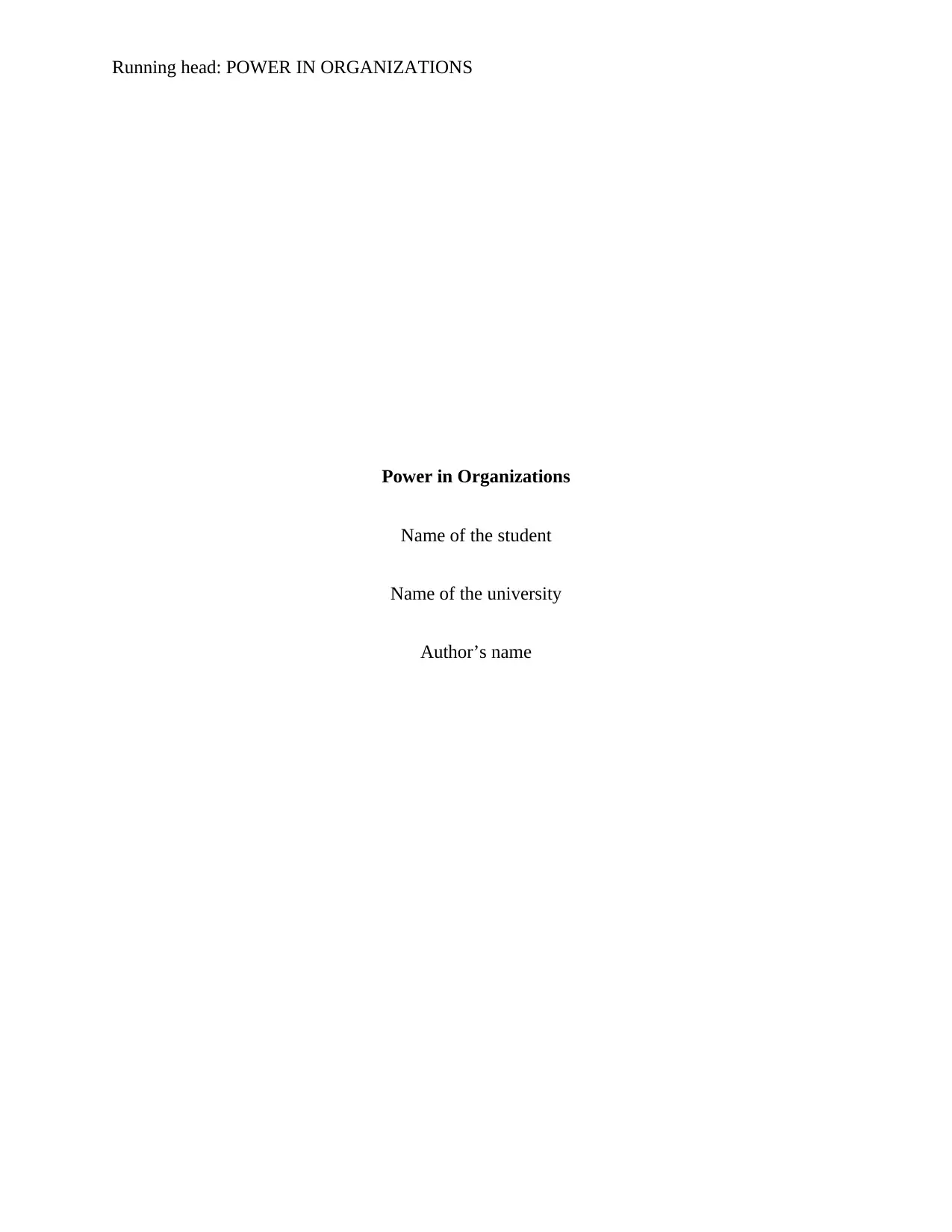
Running head: POWER IN ORGANIZATIONS
Power in Organizations
Name of the student
Name of the university
Author’s name
Power in Organizations
Name of the student
Name of the university
Author’s name
Paraphrase This Document
Need a fresh take? Get an instant paraphrase of this document with our AI Paraphraser
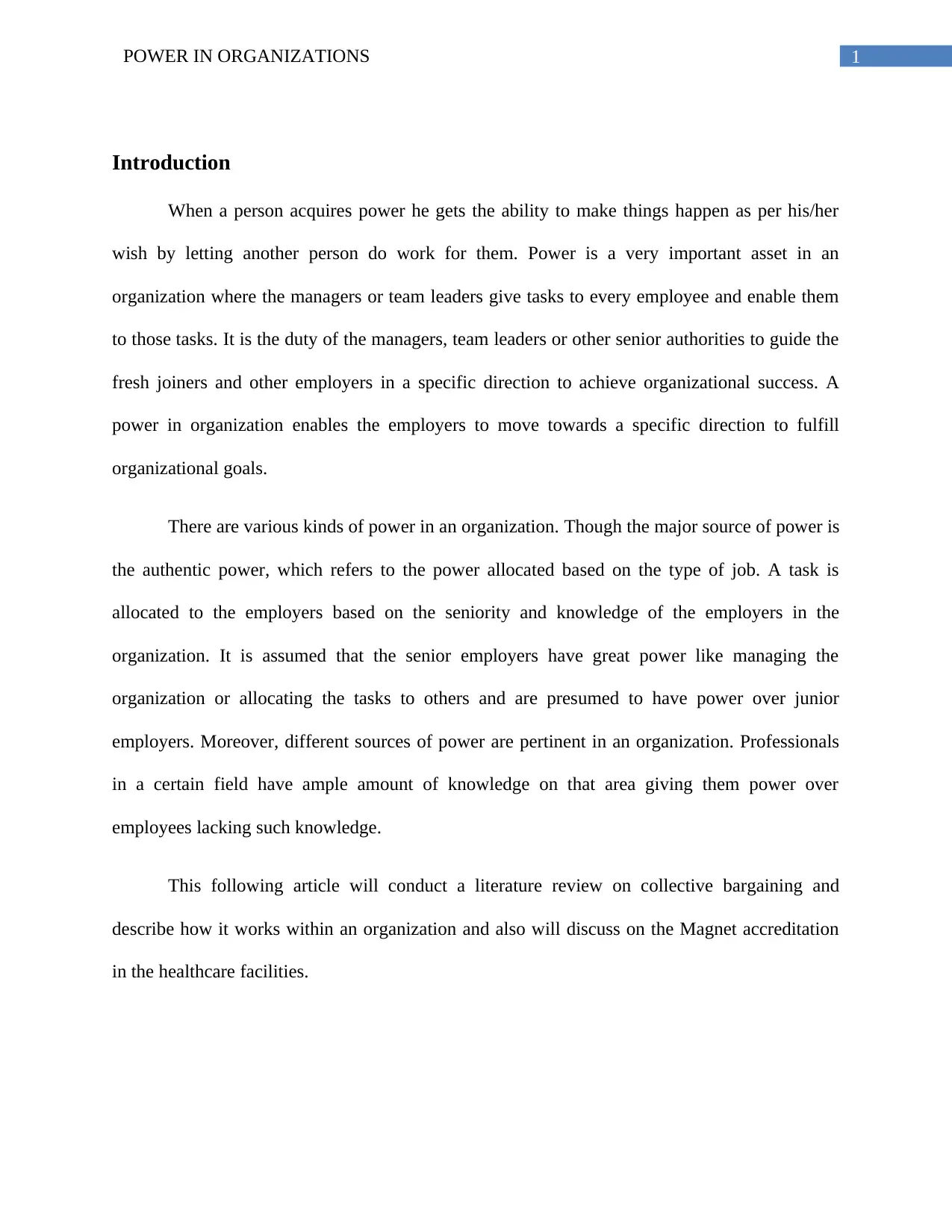
1POWER IN ORGANIZATIONS
Introduction
When a person acquires power he gets the ability to make things happen as per his/her
wish by letting another person do work for them. Power is a very important asset in an
organization where the managers or team leaders give tasks to every employee and enable them
to those tasks. It is the duty of the managers, team leaders or other senior authorities to guide the
fresh joiners and other employers in a specific direction to achieve organizational success. A
power in organization enables the employers to move towards a specific direction to fulfill
organizational goals.
There are various kinds of power in an organization. Though the major source of power is
the authentic power, which refers to the power allocated based on the type of job. A task is
allocated to the employers based on the seniority and knowledge of the employers in the
organization. It is assumed that the senior employers have great power like managing the
organization or allocating the tasks to others and are presumed to have power over junior
employers. Moreover, different sources of power are pertinent in an organization. Professionals
in a certain field have ample amount of knowledge on that area giving them power over
employees lacking such knowledge.
This following article will conduct a literature review on collective bargaining and
describe how it works within an organization and also will discuss on the Magnet accreditation
in the healthcare facilities.
Introduction
When a person acquires power he gets the ability to make things happen as per his/her
wish by letting another person do work for them. Power is a very important asset in an
organization where the managers or team leaders give tasks to every employee and enable them
to those tasks. It is the duty of the managers, team leaders or other senior authorities to guide the
fresh joiners and other employers in a specific direction to achieve organizational success. A
power in organization enables the employers to move towards a specific direction to fulfill
organizational goals.
There are various kinds of power in an organization. Though the major source of power is
the authentic power, which refers to the power allocated based on the type of job. A task is
allocated to the employers based on the seniority and knowledge of the employers in the
organization. It is assumed that the senior employers have great power like managing the
organization or allocating the tasks to others and are presumed to have power over junior
employers. Moreover, different sources of power are pertinent in an organization. Professionals
in a certain field have ample amount of knowledge on that area giving them power over
employees lacking such knowledge.
This following article will conduct a literature review on collective bargaining and
describe how it works within an organization and also will discuss on the Magnet accreditation
in the healthcare facilities.
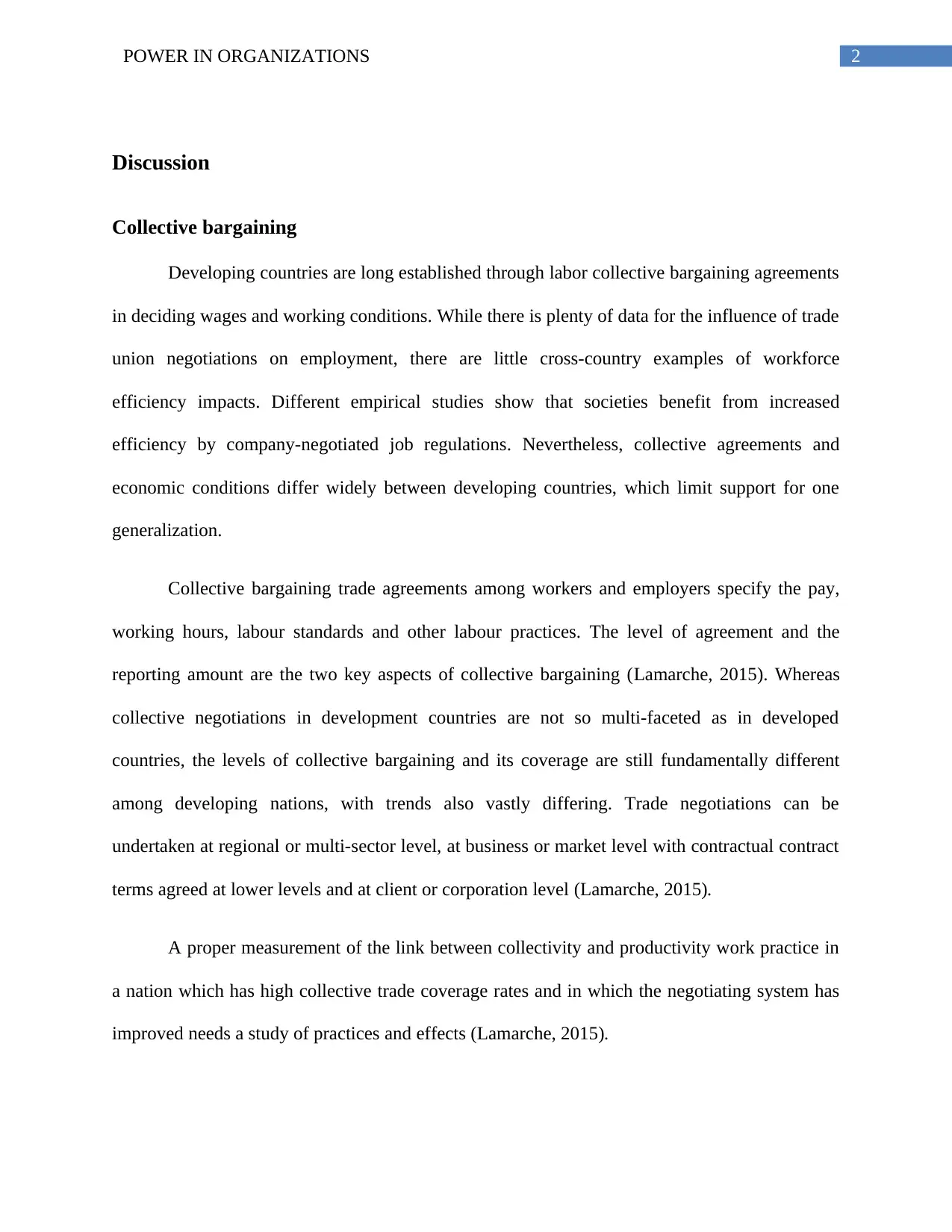
2POWER IN ORGANIZATIONS
Discussion
Collective bargaining
Developing countries are long established through labor collective bargaining agreements
in deciding wages and working conditions. While there is plenty of data for the influence of trade
union negotiations on employment, there are little cross-country examples of workforce
efficiency impacts. Different empirical studies show that societies benefit from increased
efficiency by company-negotiated job regulations. Nevertheless, collective agreements and
economic conditions differ widely between developing countries, which limit support for one
generalization.
Collective bargaining trade agreements among workers and employers specify the pay,
working hours, labour standards and other labour practices. The level of agreement and the
reporting amount are the two key aspects of collective bargaining (Lamarche, 2015). Whereas
collective negotiations in development countries are not so multi-faceted as in developed
countries, the levels of collective bargaining and its coverage are still fundamentally different
among developing nations, with trends also vastly differing. Trade negotiations can be
undertaken at regional or multi-sector level, at business or market level with contractual contract
terms agreed at lower levels and at client or corporation level (Lamarche, 2015).
A proper measurement of the link between collectivity and productivity work practice in
a nation which has high collective trade coverage rates and in which the negotiating system has
improved needs a study of practices and effects (Lamarche, 2015).
Discussion
Collective bargaining
Developing countries are long established through labor collective bargaining agreements
in deciding wages and working conditions. While there is plenty of data for the influence of trade
union negotiations on employment, there are little cross-country examples of workforce
efficiency impacts. Different empirical studies show that societies benefit from increased
efficiency by company-negotiated job regulations. Nevertheless, collective agreements and
economic conditions differ widely between developing countries, which limit support for one
generalization.
Collective bargaining trade agreements among workers and employers specify the pay,
working hours, labour standards and other labour practices. The level of agreement and the
reporting amount are the two key aspects of collective bargaining (Lamarche, 2015). Whereas
collective negotiations in development countries are not so multi-faceted as in developed
countries, the levels of collective bargaining and its coverage are still fundamentally different
among developing nations, with trends also vastly differing. Trade negotiations can be
undertaken at regional or multi-sector level, at business or market level with contractual contract
terms agreed at lower levels and at client or corporation level (Lamarche, 2015).
A proper measurement of the link between collectivity and productivity work practice in
a nation which has high collective trade coverage rates and in which the negotiating system has
improved needs a study of practices and effects (Lamarche, 2015).
⊘ This is a preview!⊘
Do you want full access?
Subscribe today to unlock all pages.

Trusted by 1+ million students worldwide
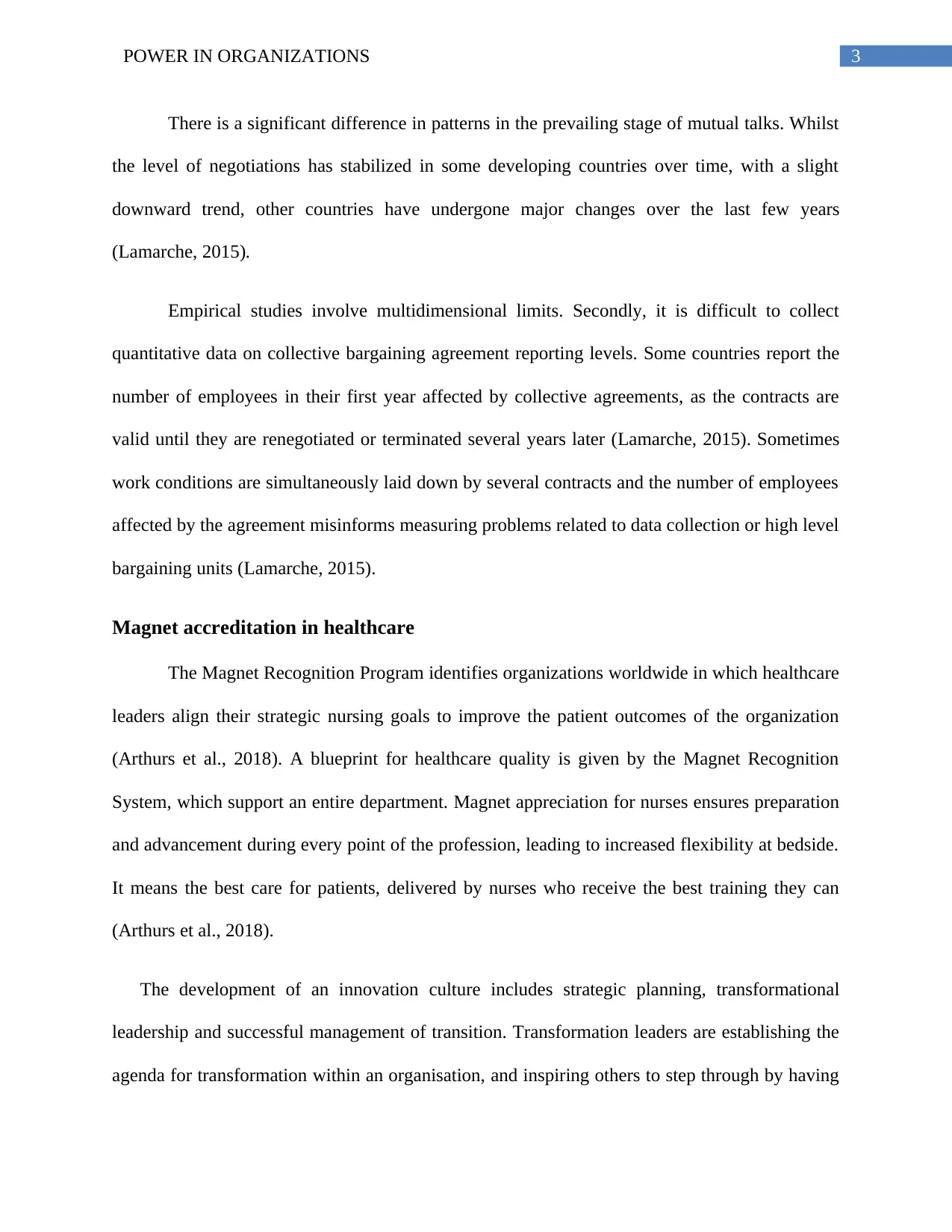
3POWER IN ORGANIZATIONS
There is a significant difference in patterns in the prevailing stage of mutual talks. Whilst
the level of negotiations has stabilized in some developing countries over time, with a slight
downward trend, other countries have undergone major changes over the last few years
(Lamarche, 2015).
Empirical studies involve multidimensional limits. Secondly, it is difficult to collect
quantitative data on collective bargaining agreement reporting levels. Some countries report the
number of employees in their first year affected by collective agreements, as the contracts are
valid until they are renegotiated or terminated several years later (Lamarche, 2015). Sometimes
work conditions are simultaneously laid down by several contracts and the number of employees
affected by the agreement misinforms measuring problems related to data collection or high level
bargaining units (Lamarche, 2015).
Magnet accreditation in healthcare
The Magnet Recognition Program identifies organizations worldwide in which healthcare
leaders align their strategic nursing goals to improve the patient outcomes of the organization
(Arthurs et al., 2018). A blueprint for healthcare quality is given by the Magnet Recognition
System, which support an entire department. Magnet appreciation for nurses ensures preparation
and advancement during every point of the profession, leading to increased flexibility at bedside.
It means the best care for patients, delivered by nurses who receive the best training they can
(Arthurs et al., 2018).
The development of an innovation culture includes strategic planning, transformational
leadership and successful management of transition. Transformation leaders are establishing the
agenda for transformation within an organisation, and inspiring others to step through by having
There is a significant difference in patterns in the prevailing stage of mutual talks. Whilst
the level of negotiations has stabilized in some developing countries over time, with a slight
downward trend, other countries have undergone major changes over the last few years
(Lamarche, 2015).
Empirical studies involve multidimensional limits. Secondly, it is difficult to collect
quantitative data on collective bargaining agreement reporting levels. Some countries report the
number of employees in their first year affected by collective agreements, as the contracts are
valid until they are renegotiated or terminated several years later (Lamarche, 2015). Sometimes
work conditions are simultaneously laid down by several contracts and the number of employees
affected by the agreement misinforms measuring problems related to data collection or high level
bargaining units (Lamarche, 2015).
Magnet accreditation in healthcare
The Magnet Recognition Program identifies organizations worldwide in which healthcare
leaders align their strategic nursing goals to improve the patient outcomes of the organization
(Arthurs et al., 2018). A blueprint for healthcare quality is given by the Magnet Recognition
System, which support an entire department. Magnet appreciation for nurses ensures preparation
and advancement during every point of the profession, leading to increased flexibility at bedside.
It means the best care for patients, delivered by nurses who receive the best training they can
(Arthurs et al., 2018).
The development of an innovation culture includes strategic planning, transformational
leadership and successful management of transition. Transformation leaders are establishing the
agenda for transformation within an organisation, and inspiring others to step through by having
Paraphrase This Document
Need a fresh take? Get an instant paraphrase of this document with our AI Paraphraser
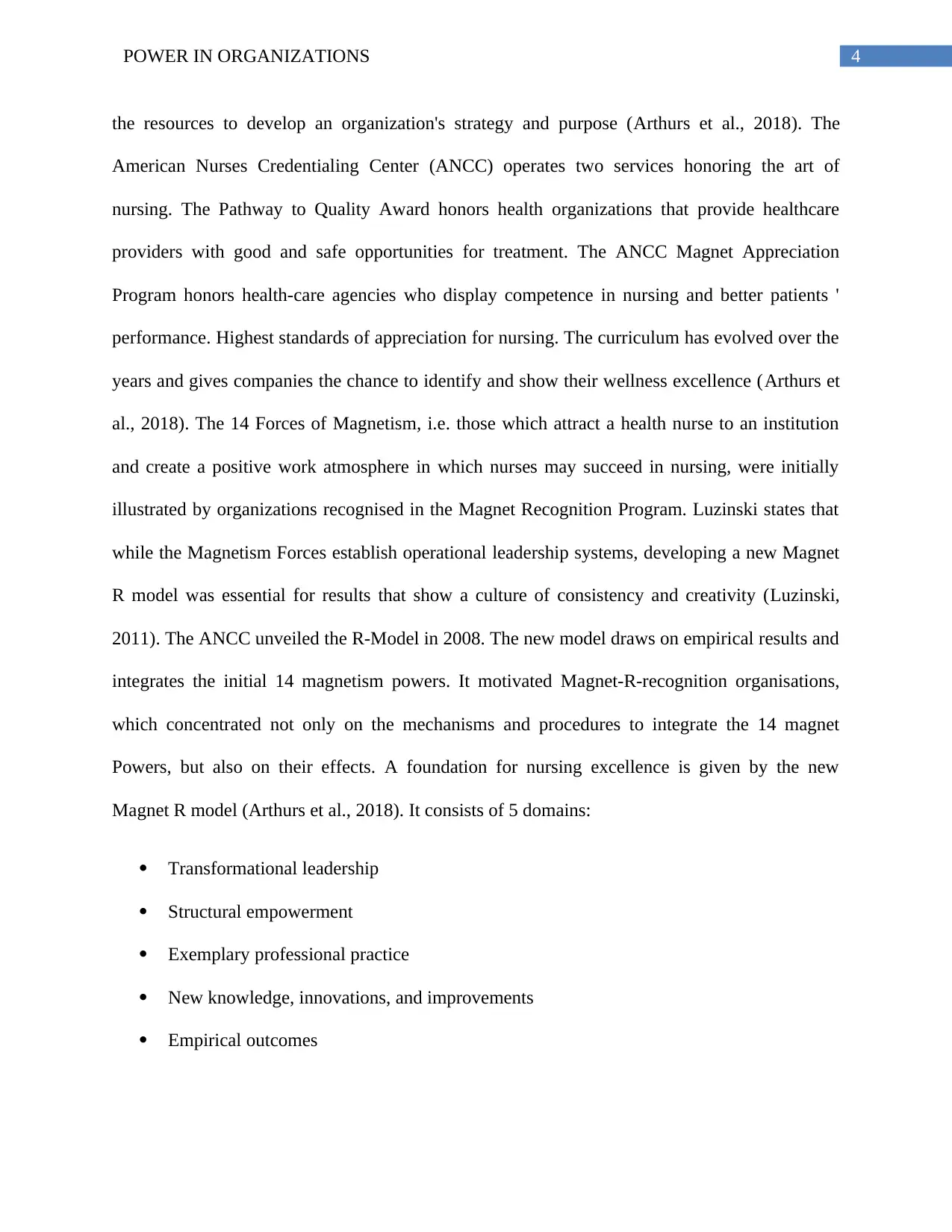
4POWER IN ORGANIZATIONS
the resources to develop an organization's strategy and purpose (Arthurs et al., 2018). The
American Nurses Credentialing Center (ANCC) operates two services honoring the art of
nursing. The Pathway to Quality Award honors health organizations that provide healthcare
providers with good and safe opportunities for treatment. The ANCC Magnet Appreciation
Program honors health-care agencies who display competence in nursing and better patients '
performance. Highest standards of appreciation for nursing. The curriculum has evolved over the
years and gives companies the chance to identify and show their wellness excellence (Arthurs et
al., 2018). The 14 Forces of Magnetism, i.e. those which attract a health nurse to an institution
and create a positive work atmosphere in which nurses may succeed in nursing, were initially
illustrated by organizations recognised in the Magnet Recognition Program. Luzinski states that
while the Magnetism Forces establish operational leadership systems, developing a new Magnet
R model was essential for results that show a culture of consistency and creativity (Luzinski,
2011). The ANCC unveiled the R-Model in 2008. The new model draws on empirical results and
integrates the initial 14 magnetism powers. It motivated Magnet-R-recognition organisations,
which concentrated not only on the mechanisms and procedures to integrate the 14 magnet
Powers, but also on their effects. A foundation for nursing excellence is given by the new
Magnet R model (Arthurs et al., 2018). It consists of 5 domains:
Transformational leadership
Structural empowerment
Exemplary professional practice
New knowledge, innovations, and improvements
Empirical outcomes
the resources to develop an organization's strategy and purpose (Arthurs et al., 2018). The
American Nurses Credentialing Center (ANCC) operates two services honoring the art of
nursing. The Pathway to Quality Award honors health organizations that provide healthcare
providers with good and safe opportunities for treatment. The ANCC Magnet Appreciation
Program honors health-care agencies who display competence in nursing and better patients '
performance. Highest standards of appreciation for nursing. The curriculum has evolved over the
years and gives companies the chance to identify and show their wellness excellence (Arthurs et
al., 2018). The 14 Forces of Magnetism, i.e. those which attract a health nurse to an institution
and create a positive work atmosphere in which nurses may succeed in nursing, were initially
illustrated by organizations recognised in the Magnet Recognition Program. Luzinski states that
while the Magnetism Forces establish operational leadership systems, developing a new Magnet
R model was essential for results that show a culture of consistency and creativity (Luzinski,
2011). The ANCC unveiled the R-Model in 2008. The new model draws on empirical results and
integrates the initial 14 magnetism powers. It motivated Magnet-R-recognition organisations,
which concentrated not only on the mechanisms and procedures to integrate the 14 magnet
Powers, but also on their effects. A foundation for nursing excellence is given by the new
Magnet R model (Arthurs et al., 2018). It consists of 5 domains:
Transformational leadership
Structural empowerment
Exemplary professional practice
New knowledge, innovations, and improvements
Empirical outcomes
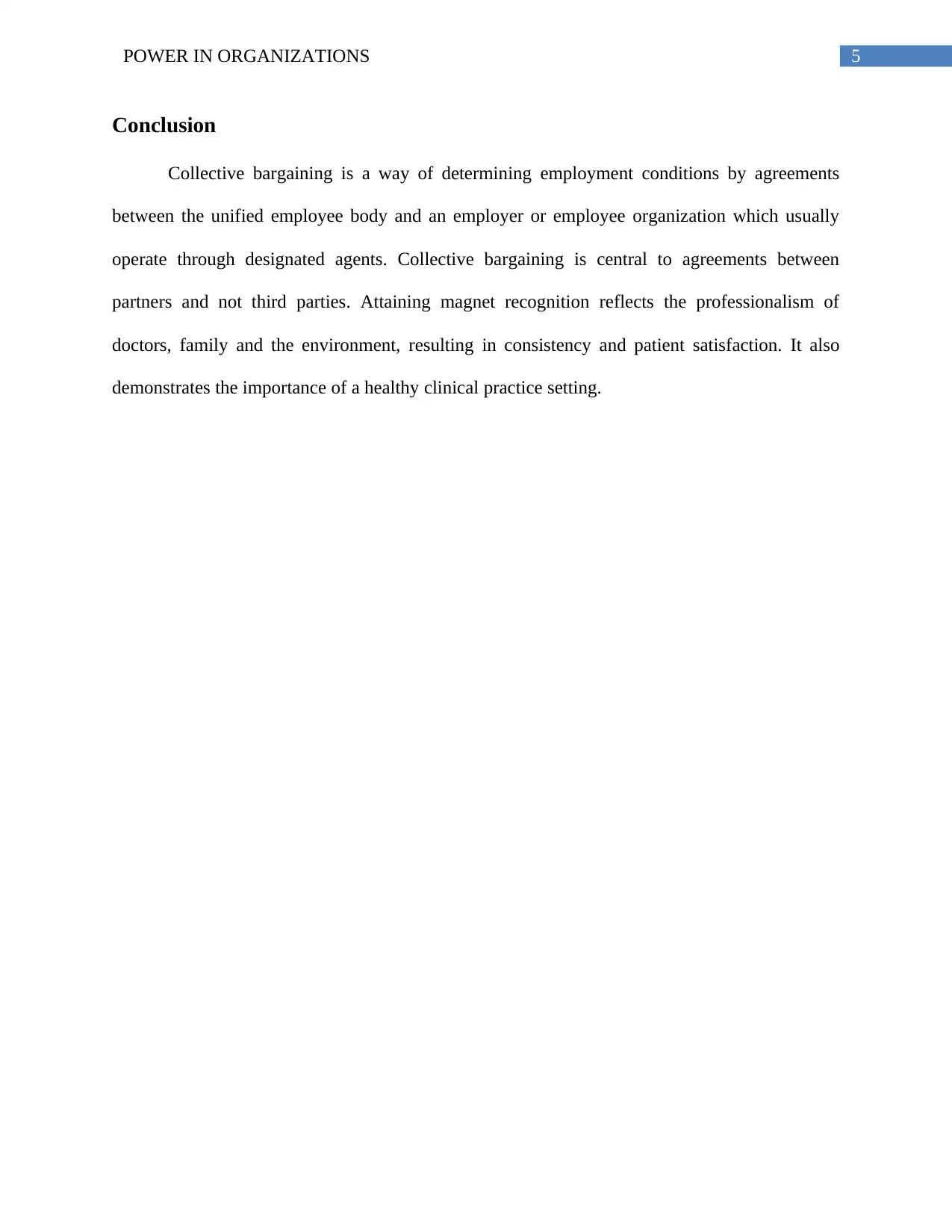
5POWER IN ORGANIZATIONS
Conclusion
Collective bargaining is a way of determining employment conditions by agreements
between the unified employee body and an employer or employee organization which usually
operate through designated agents. Collective bargaining is central to agreements between
partners and not third parties. Attaining magnet recognition reflects the professionalism of
doctors, family and the environment, resulting in consistency and patient satisfaction. It also
demonstrates the importance of a healthy clinical practice setting.
Conclusion
Collective bargaining is a way of determining employment conditions by agreements
between the unified employee body and an employer or employee organization which usually
operate through designated agents. Collective bargaining is central to agreements between
partners and not third parties. Attaining magnet recognition reflects the professionalism of
doctors, family and the environment, resulting in consistency and patient satisfaction. It also
demonstrates the importance of a healthy clinical practice setting.
⊘ This is a preview!⊘
Do you want full access?
Subscribe today to unlock all pages.

Trusted by 1+ million students worldwide
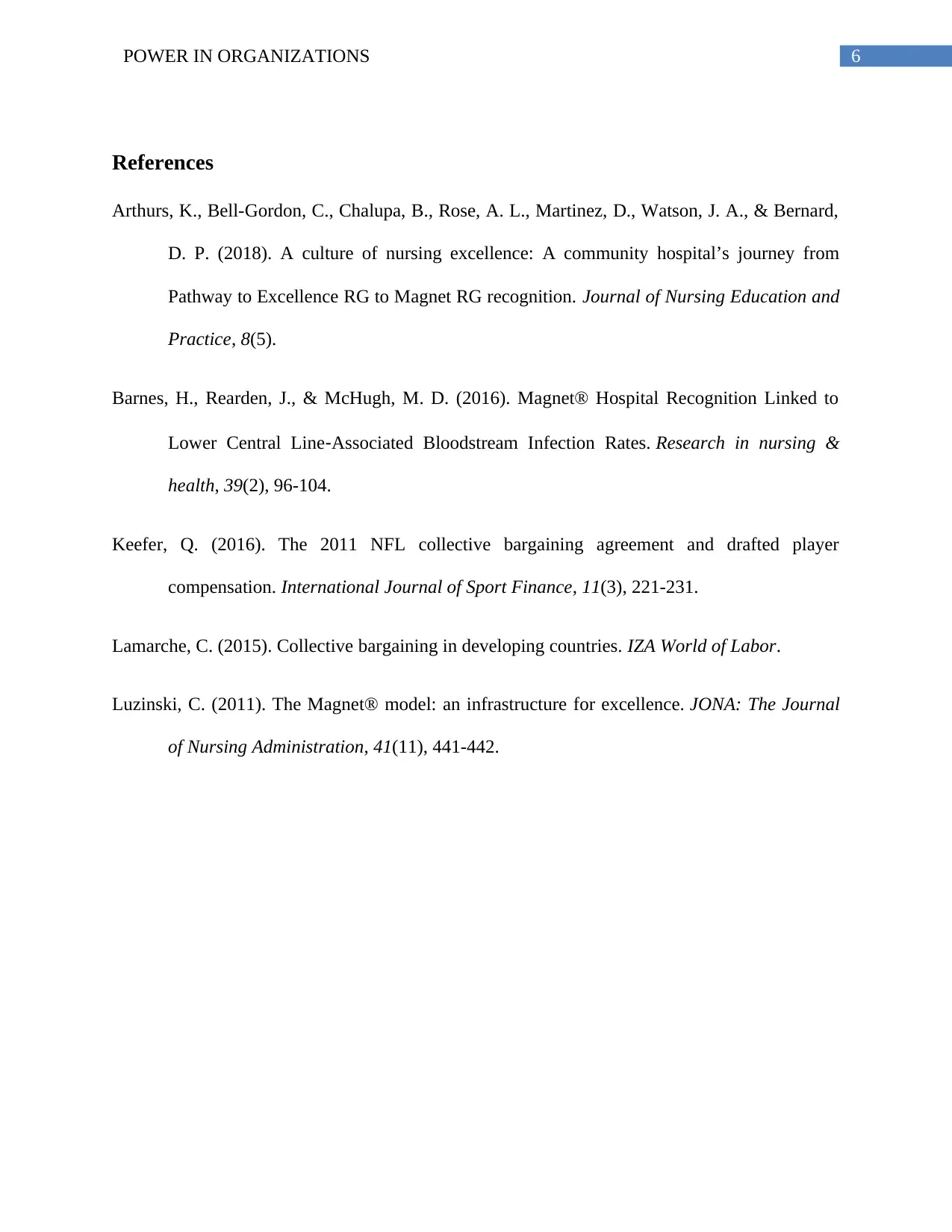
6POWER IN ORGANIZATIONS
References
Arthurs, K., Bell-Gordon, C., Chalupa, B., Rose, A. L., Martinez, D., Watson, J. A., & Bernard,
D. P. (2018). A culture of nursing excellence: A community hospital’s journey from
Pathway to Excellence RG to Magnet RG recognition. Journal of Nursing Education and
Practice, 8(5).
Barnes, H., Rearden, J., & McHugh, M. D. (2016). Magnet® Hospital Recognition Linked to
Lower Central Line‐Associated Bloodstream Infection Rates. Research in nursing &
health, 39(2), 96-104.
Keefer, Q. (2016). The 2011 NFL collective bargaining agreement and drafted player
compensation. International Journal of Sport Finance, 11(3), 221-231.
Lamarche, C. (2015). Collective bargaining in developing countries. IZA World of Labor.
Luzinski, C. (2011). The Magnet® model: an infrastructure for excellence. JONA: The Journal
of Nursing Administration, 41(11), 441-442.
References
Arthurs, K., Bell-Gordon, C., Chalupa, B., Rose, A. L., Martinez, D., Watson, J. A., & Bernard,
D. P. (2018). A culture of nursing excellence: A community hospital’s journey from
Pathway to Excellence RG to Magnet RG recognition. Journal of Nursing Education and
Practice, 8(5).
Barnes, H., Rearden, J., & McHugh, M. D. (2016). Magnet® Hospital Recognition Linked to
Lower Central Line‐Associated Bloodstream Infection Rates. Research in nursing &
health, 39(2), 96-104.
Keefer, Q. (2016). The 2011 NFL collective bargaining agreement and drafted player
compensation. International Journal of Sport Finance, 11(3), 221-231.
Lamarche, C. (2015). Collective bargaining in developing countries. IZA World of Labor.
Luzinski, C. (2011). The Magnet® model: an infrastructure for excellence. JONA: The Journal
of Nursing Administration, 41(11), 441-442.
1 out of 7
Related Documents
Your All-in-One AI-Powered Toolkit for Academic Success.
+13062052269
info@desklib.com
Available 24*7 on WhatsApp / Email
![[object Object]](/_next/static/media/star-bottom.7253800d.svg)
Unlock your academic potential
Copyright © 2020–2025 A2Z Services. All Rights Reserved. Developed and managed by ZUCOL.





